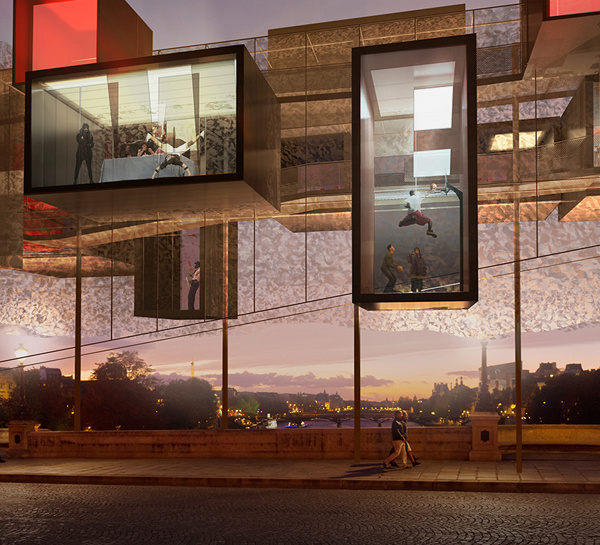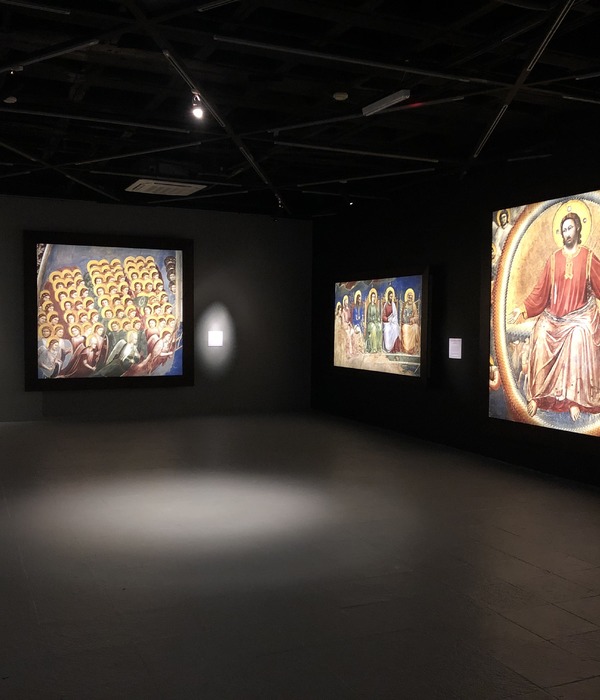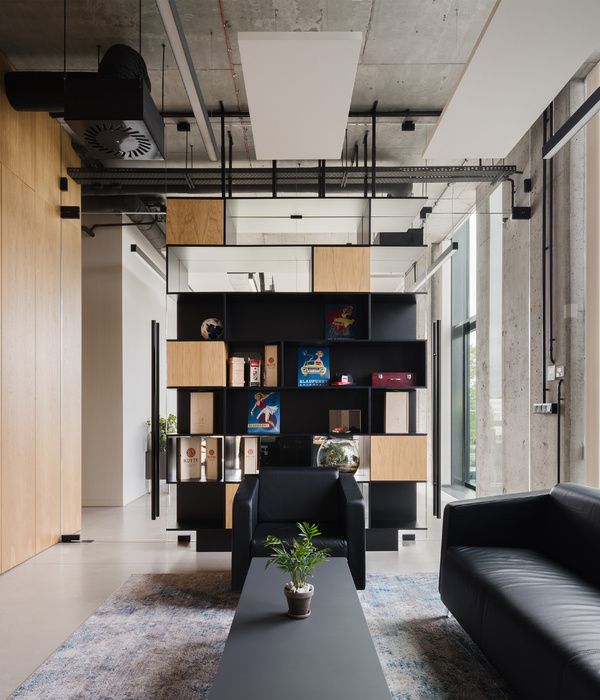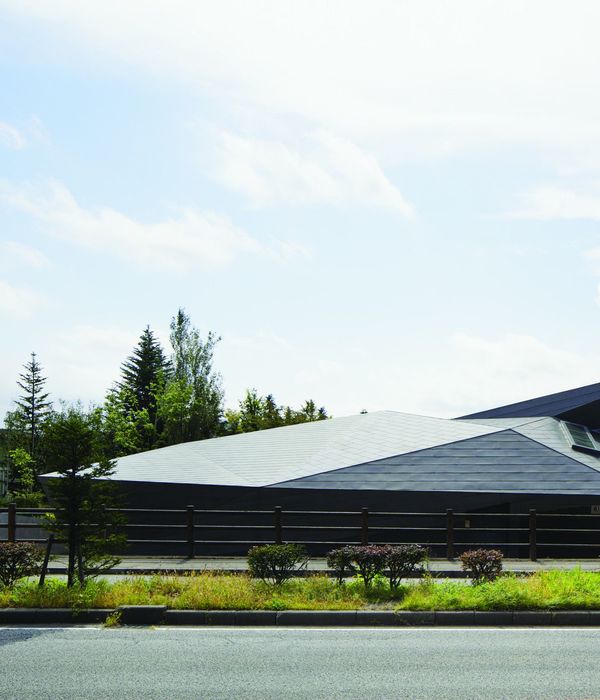- 项目名称:树林里的图书室
- 地点:上海市崇明区前哨村
- 主持建筑师:王少榕
- 设计团队:王少榕,王茵,张馨艺(实习)
- 业主:上海市崇明区文化和旅游局
- 项目造价:100万元
- 建成状态:建成
- 设计时间:2020年6月-8月
- 建设时间:2021年2月
- 建筑面积:178平方米
- 主要材料:杉木桩,杉木板,红砖
- 摄影:朱润资(部分照片为胶片摄影)
前哨村位于崇明岛的北部,从1968年开始围垦至今已41年。前哨湾艺术部落便坐落于此,意图通过“艺术旅游”这样一种形式让崇明岛发展出新兴的文化经济产业。图书室原先是一栋破败的平房,为前哨小学校舍。校舍年久失修已经成为危房,受当地政府委托,我们在拆除后的原址新建一座图书室,同时兼备咖啡馆的功能,作为服务于前哨湾艺术部落的配套设施。
Qianshao Village is located in the northern part of Chongming Island. It has been 41 years since the reclamation began in 1968. Qianshao Bay Art Tribe is launched with a intention to develop a new cultural and economic industry in Chongming Island through the form of ‘art tourism’. The library used to be a run-down bungalow that served as the primary school in this village. We were commissioned by the local government to build a new library and cafe on the site of the demolished school, which will also become a supporting facility for the Art Tribe.
▼雾中的树林图书室,library in the mist ©朱润资
2020年5月的初次踏勘现场之后,我们被前哨湾大片的苗木林所吸引。漫步其中,可以感受到城市生活中难得一见的与自然的亲近。 “ 如何用具象表现抽象?” “如何通过建筑氛围让人感受自然意境?” 设计试图将这种树林的自然景象转译为建筑氛围,在现实与超现实、具象与抽象的转化中展现自然与建筑的和谐共处。
After our first visit to the site in May 2020, we were attracted by the large nursery forest in Qianshao Bay. When meandering throug it, you can feel the closeness with nature that is rarely seen in city life. ‘How to visualize abstraction with concrete design?’ ‘How to make people feel the natural mood through architectural atmosphere?’ The design attempts to interpret the natural scene of the forest into an architectural atmosphere, showing the harmonious coexistence of the nature and architecture in the interpretation between real and surreal, figurative and abstract.
▼校舍原状,the existing building ©空间里
▼左:苗木林环境;右:英国超现实主义画家 玛格丽特·吉利斯 left: the nursery forest; right: British painter Margaret Gillies©空间里
▼设计概念,design concept ©空间里
在回工作室的路上我们无意间碰到一辆载满了木桩的卡车,作为河道设施材料的柱子启发了我对“人工树林”的想象。在设计中,我们用杉木桩布置成“树林”, 消除了房子的固有几何形象,弱化建筑的外在边界,将周边的环境营造成像树林那样朦胧、虚幻、具有神秘感。柱林共使用了300根木桩,直径是150mm和200mm两种规格,露出地面的高度有2.5m、3m、3.5m、5m、6m五个长度,利用近大远小、近疏远密的视觉原理进行巧妙布局,产生更大更深的视觉效果,使“树林”和“林深处”的图书室在一个狭小的场地内形成了纵深感极强烈的空间体验。人在独特的空间再现手段和近大远小的生活经验同时作用下,能从无深度的画面中感受到空间的延伸和放大。
On the way back to our studio, we came across a truck full of wood piles, which are usually used as the material for the river engineering and inspired my imagination of the ‘artificial forest’. In this design, we use cedar piles to form a ‘forest’, which eliminates the stereotype about the geometry of a house, weakens the external boundary of the building, and creates the surrounding environment as hazy, illusory and mysterious as the forest. The ‘forest’ uses a total of 300 wood piles, with two specifications of diameter:150mm and 200mm, and the height of the exposion above ground has five different lengths: 2.5m, 3m, 3.5m, 5m, 6m. The subtle layout is based on the simple visual priciple to create a larger and deeper visual effect. The ‘forest’ and ‘library deep in the forest’ form a strong spatial experience in depth on a narrow site. People can feel the extension and enlargement of space from the scene without depth under the effect of unique means of space reproduction and life experience.
▼沿街立面,street view ©朱润资
▼木桩树林,a forest of wood piles ©朱润资
▼建筑入口,entrance ©朱润资
▼穿过“树林”后回望,looking back to the “forest” ©朱润资
穿过“树林”,是一段连接图书室和河畔庭院的过廊。在镜面墙的反射中,视觉里的空间边界似乎消失了。人、树林、河畔景色的相互反射,形成从非现实转化到现实的过渡空间。
Walking through the ‘woods’, there is a passage that connects the library to the riverside courtyard. In the reflection of the mirror wall, the visual boundary of space seems to disappear. The reflection of people, trees and riverside scenery forms a transition space from non-reality to reality
▼室内空间,interior view ©朱润资
▼北面的大落地窗,the north-facing glazed wall ©朱润资
▼北面窗外的河岸景色,view to the river band on the north side ©朱润资
长方形的建筑空间规整而通透,设计中没有做过多的分隔,以便适应运营中不同的功能需求。室内的桌凳等家具采用原木作为材料,结合大面积的落地开窗,将基地周边环境的自然属性容纳进建筑内部。
The rectangular space is simple in geometry without too much separation designed inside, in order to adapt to different functional needs of future operation. Indoor furniture such as tables and stools are made of log, with large French Windows on side, the natural surrenderings of the site are accommodated into the architectre.
▼南面的落地窗,the south-facing glazed wall ©朱润资
▼南面窗外的“柱林”,view to the pile forest on the south side ©朱润资
面向道路一侧的视野被柱林遮挡,亦隔绝了道路带来的干扰,室内空间更显静谧。柱林的影子投影在室内,在遮蔽午间强烈的日光的同时,也让室内充满了深处树林的氛围感。
View on the side facing the road is blocked by the pile forest, which also isolates the interference, making the interior space much more quiet. The ‘forest’ casts a shadow into the building, shading the strong midday daylight and also giving the interior a sense of deep forest.
▼河对岸的树林图书室,Underwood Library across from the river ©朱润资
▼雾中的北面窗景,north-facing window ©朱润资
▼雾中的过廊,the corridor in the mist ©朱润资
▼雾中的图书室入口,the library entrance in the mist ©朱润资
▼雾中的树林图书室,Underwood Library in the mist ©朱润资
▼树林图书室,Underwood Library ©朱润资
▼建筑轴测,axon ©空间里
项目名称:树林里的图书室 项目类型:建筑、室内、景观设计 项目地点:上海市崇明区前哨村 主持建筑师:王少榕 项目主管/项目建筑师:祝佳雷、王少榕 设计团队:王少榕、王茵、张馨艺(实习) 业主:上海市崇明区文化和旅游局 项目造价:100万元 建成状态:建成 设计时间:2020年6月-8月 建设时间:2021年2月 建筑面积:178平方米 主要材料:杉木桩、杉木板、红砖 摄影:朱润资(部分照片为胶片摄影)
Project Name: Underwood Library Type: Architecture, Interior, Landscape Location: Qianshao Village, Chongming District, Shanghai Design Principal: Wang Shaorong Project Leader/ Project Architect: Zhu Jialei, Wang Shaorong Design Team: Wang Yin, Zhang Xinyi (Intern) Client: Shanghai Chongming District Culture and Tourism Bureau Cost: 1million RMB Status: Built Design Stage: 2020.June-August Construction Stage: February 2021 Building Area: 178spm Main Material: Cedar Pile, Cedar Plank, Red Bricks Photography: Zhu Runzi
{{item.text_origin}}












